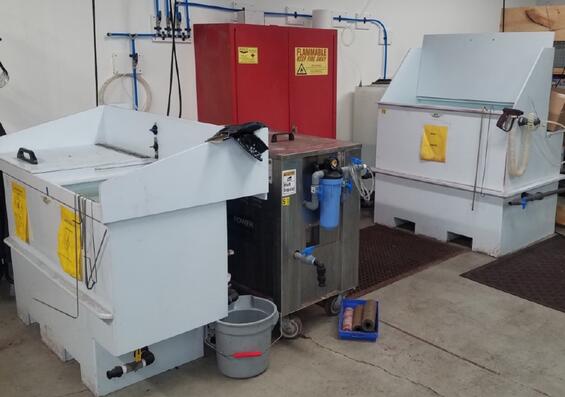Background
S.E. Shires was founded in Hopedale, MA, in 1995. The company has long been recognized as a leader in brass instrument design and craftsmanship. Promotional materials for S.E. Shires feature Doc Severinsen, Blair Bollinger, George Curran and more famous names who vouch for the quality of sound that S.E. Shires’ clients can expect. In 2014, Eastman Music Company of California purchased the S.E Shires Company which relocated to Holliston, MA, in 2018
Process
S.E. Shires craftsman at work, Hopedale, MA
At S.E. Shires, it takes approximately 8 to 10 days to finish each trombone and slightly less than that to finish a trumpet. The selected sheet alloys are cut, drawn, shaped, brazed, buffed, bright-dipped, and lacquered at the facility in Holliston, MA.
Eliminating Trichloroethylene (TCE)
Since the mid-1990s, the company has worked with OTA to improve worker health and safety and reduce the presence of toxics on the shop floor. Chuck Shepard, Director of Safety and Master Craftsman at S.E. Shires, works to make safety a priority and reduce the risk of worker exposures to toxic and hazardous chemicals.
A thick pitch is used during the shaping process for the bells and larger parts of the instrument tubing. Previously, workers used TCE to remove the pitch residue after shaping. After this cleaning stage, the shaped part would be transferred to the buffing station where a stearate-based buffing compound is used. Following that step, the buffing compound would be removed from the parts using TCE in a vapor degreaser.
Over the years, S.E. Shires made several efforts to eliminate its use of TCE. These included testing aqueous cleaners and briefly using n-propyl bromide (nPB), a drop-in vapor degreasing solvent substitute for TCE.
While assisting S.E Shires in 2016 on some compliance topics, OTA also suggested additional steps to reduce chemical use that could be developed prior to the anticipated facility relocation. A newer degreasing solvent substitute was again considered but would have had similar worker exposure concerns and cost considerably more to use. A renewed effort to switch from vapor degreasing to aqueous cleaning ensued and aqueous cleaning has been fully implemented at the new Holliston facility. The TCE previously used to remove pitch residues has also been replaced with a citrus-based cleaner which performs as well as TCE. As of 2018, TCE is no longer used at S.E. Shires.
Eliminating Methylene Chloride

Right to left: Benzyl alcohol lacquer strip and rinse, ultrasonic aqueous system, rinse tank
Previously, workers used methylene chloride to strip for re-lacquering any instruments or parts not meeting quality control standards. This part of the operation is not regularly used; however, the company was concerned about worker safety and continued to look for safer alternatives. In 2017, the facility was able to successfully switch to a benzyl alcohol lacquer stripper and eliminate the annual use of 300 pounds methylene chloride.
“I’m proud that we’ve been able to implement these changes and improve safety for our workers. OTA has been helpful and encouraging throughout this process and through all of the years that we’ve worked with them.”
Right from the Start at the Holliston Facility
S.E. Shires had their grand opening in Holliston, May 2018. While planning for the relocation, the company evaluated opportunities to upgrade equipment and make improvements to environmental and worker safety in the new facility. Besides the new aqueous cleaning and lacquer stripping systems, S.E. Shires has also installed a larger spray booth built to meet current environmental and safety standards. James Monaghan, General Manager, put significant thought into how the new facility should be organized so that production flows more efficiently. In the near future, as a result of business brought in by Eastman Music Company, the Holliston facility is preparing for a 50% increase in production with new process equipment using less toxic chemistries. Operations are now free of any chlorinated, brominated, or fluorinated solvents.

S.E. Shires brass instruments
Published 2018